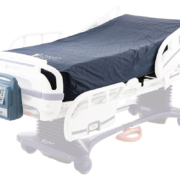Pressure redistribution system adapts surface to conform to body
A unique, patented technology that re-distributes pressure to prevent tissue damage by emulating the effects of a body “floating” in a fluid medium is now available for hospitals and long-term care facilities. All Dolphin FIS (Fluid Immersion Simulation) surfaces provide an environment that promotes tissue perfusion and prevents injury related to compromised blood flow. Dolphin FIS has been proven clinically effective at speeding the healing of advanced stage or multiple pressure ulcers, flaps, skin grafts, burns and other wound conditions and is available for beds and seat cushions, providing protection for high risk patients throughout their hospital stay or at home. Dolphin FIS software uses complex algorithms, a microprocessor and sophisticated dynamic pressure waveform analysis to precisely adjust the density of the surface for the unique anatomical features of the patient. It continuously monitors the patient’s weight, 3D surface area and movements to automatically calculate the exact settings to effectively manage the pressure of the patient’s body in the medium. The result is that the patient is truly floating, cradled in a simulated fluid environment and suspended in a near neutrally buoyant state. Distortion to the body is minimized and orientation of bone, muscle and subcutaneous tissue is normalized.
Dolphin FIS is the first and only technology proven to maintain near normal blood flow and prevent pressure injuries across the care continuum. The system is mobile and is available for most frames in a hospital, including hospital beds, stretchers, wheelchairs, and bariatric and pediatric surfaces. It’s a standardized intervention that provides a single, cost-effective solution for operating rooms, post-anesthesia care units, coronary care units, intensive care units, spinal cord injury units, medical-surgical units, emergency departments and long-term care facilities. Dolphin FIS technology is extremely easy to use. There’s virtually no programming, no manual data input, and no need for caregiver/staff intervention. The system is simply plugged into the wall and the patient is placed on the surface.


